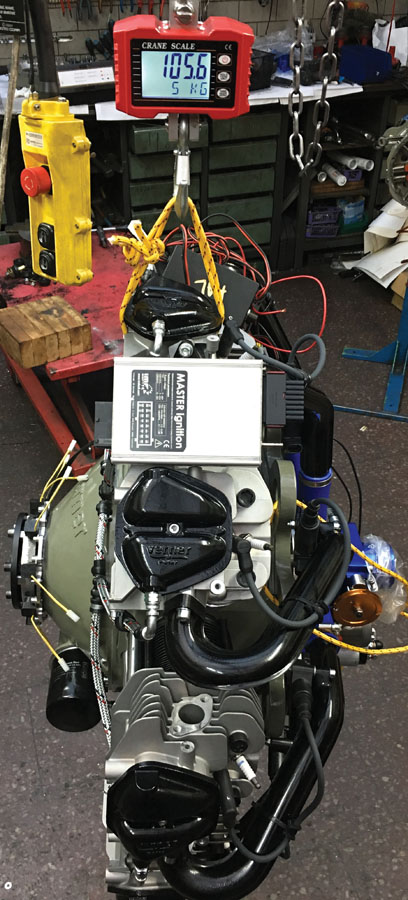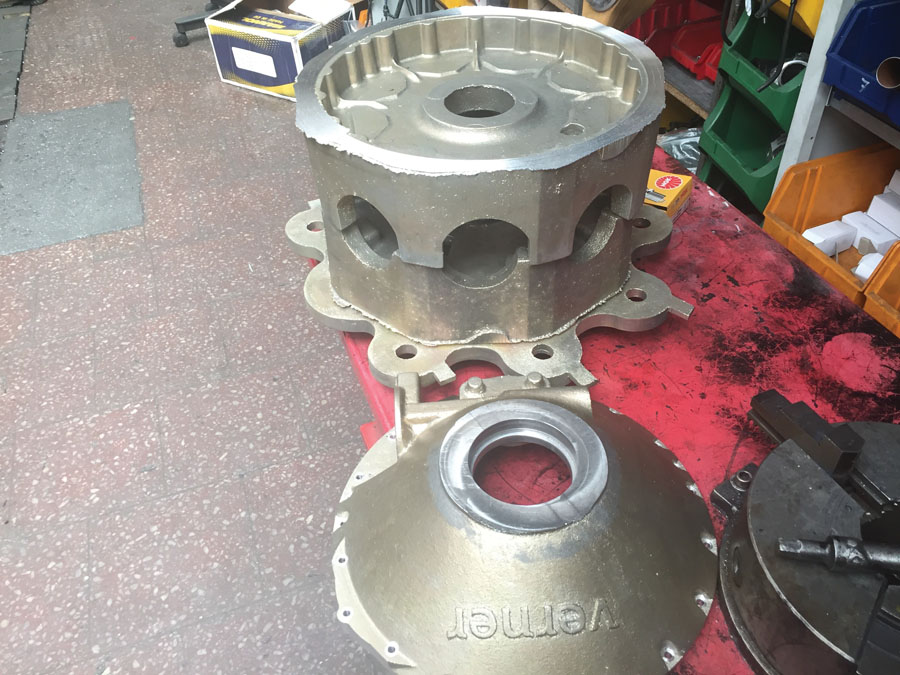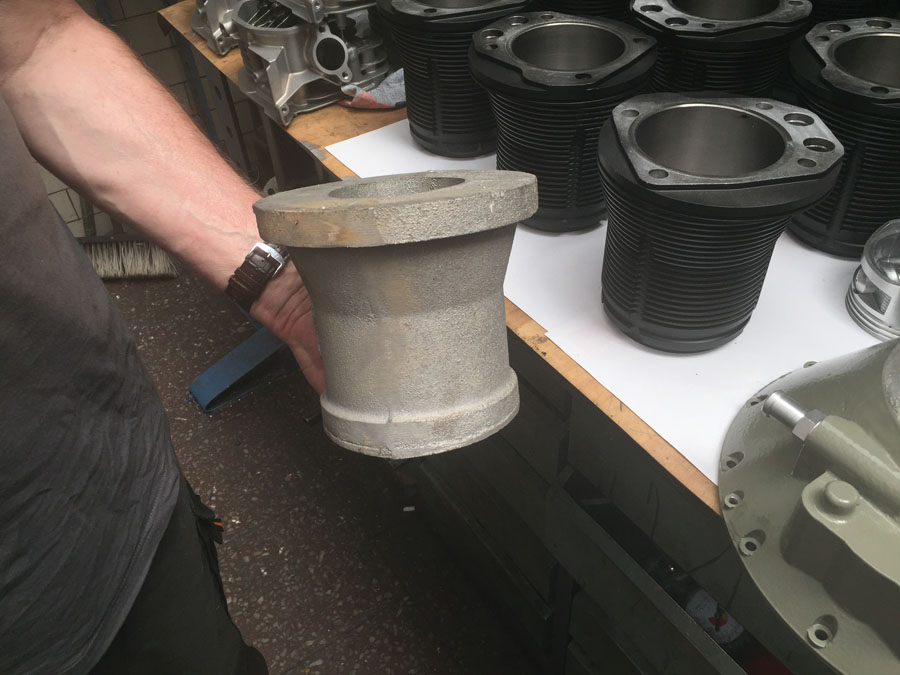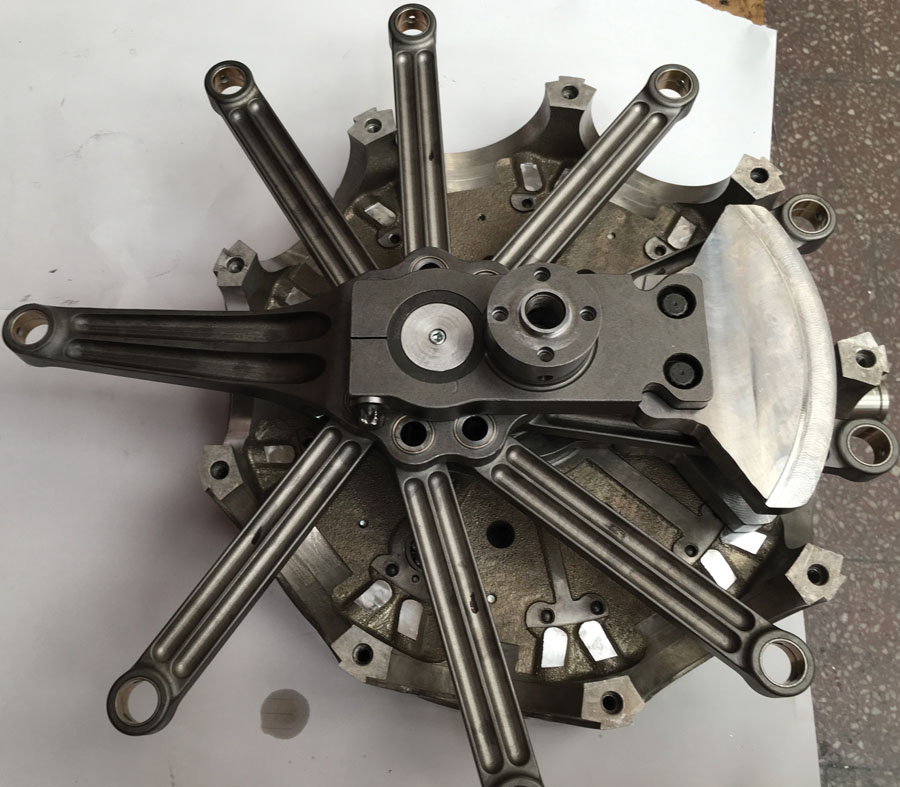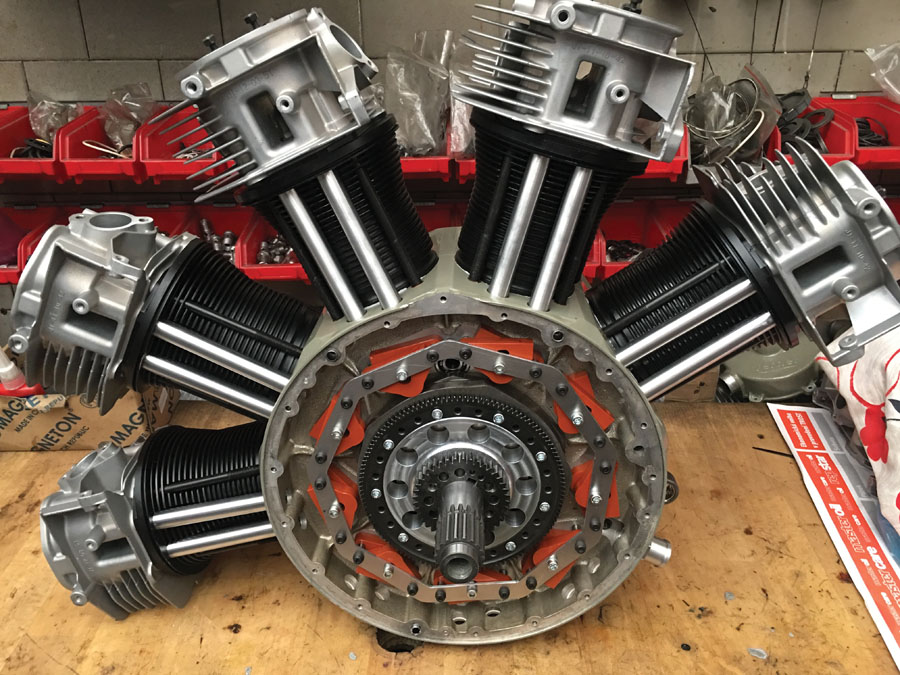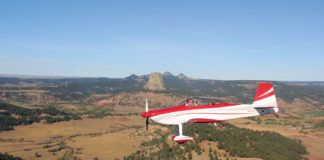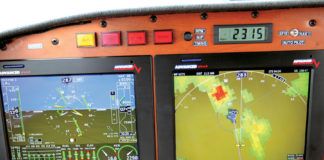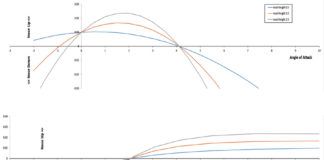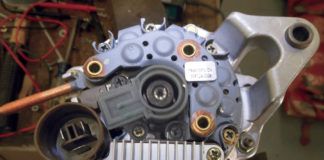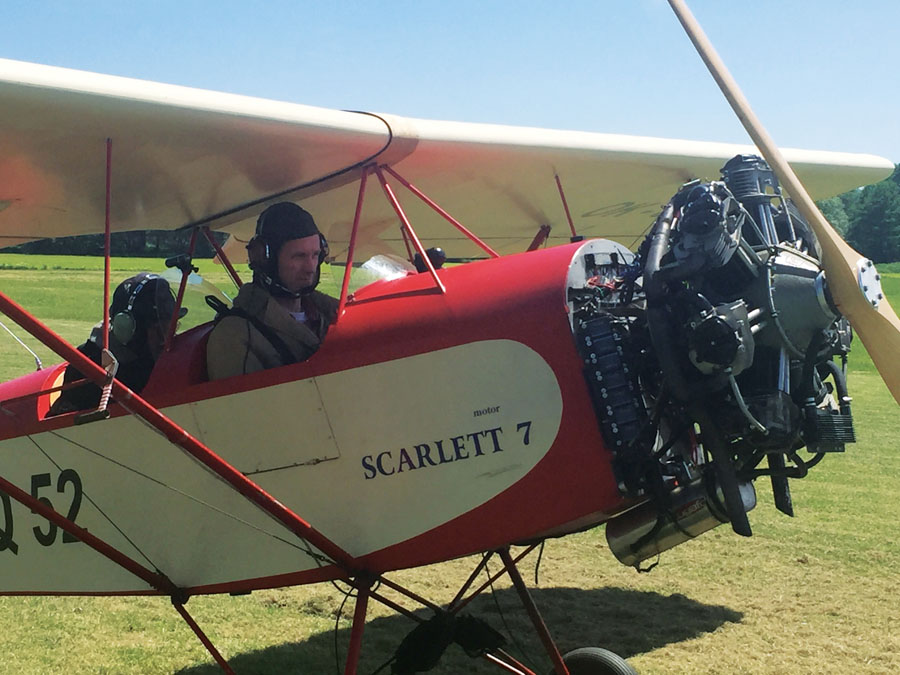
Pravoslav Verner (left) and John Christian in the Racek CRD with Scarlett 7Si engine, just prior to flight.
As my first attempt at a homebuilt aircraft stumbled into its fifth year of do-overs, the search for an appropriate powerplant to install in the Sopwith Camel WW-I replica began in earnest. Rotary engines, used 100 years ago on the original, are far too rare and unreliable. A modern reproduction, while available, is too expensive. Modern opposed engines are too physically dissimilar from the originals to allow for the level of authenticity that I want to achieve. A small radial engine of about 150 hp was needed. Unfortunately, there are precious few options that match this description.
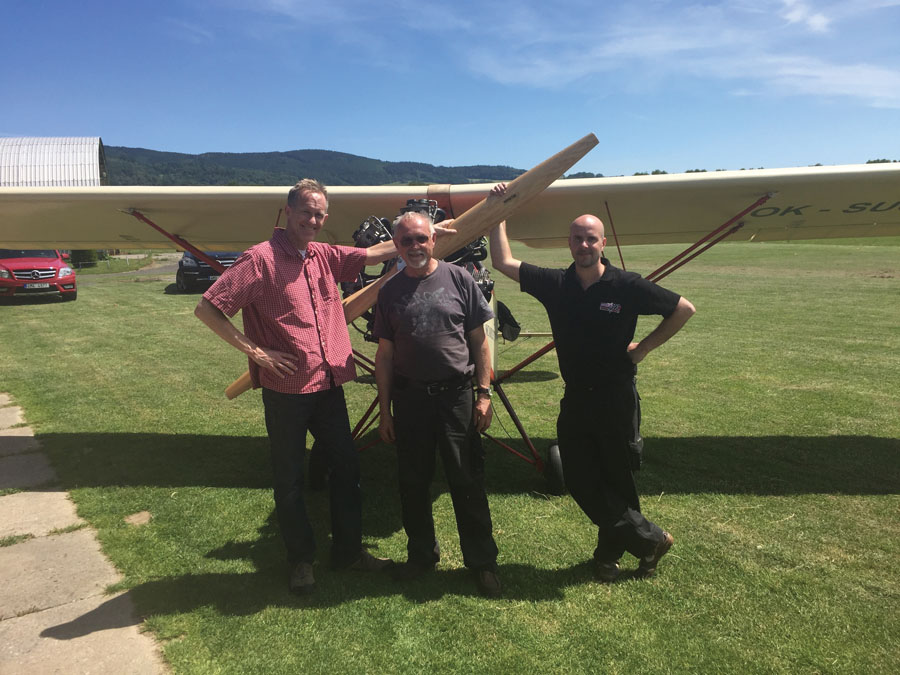
Left to right: John Christian, Pravoslav Verner, and Kamil Verner in front of Racek CRD after John’s introductory flight.
In March 2017, Verner Motor, a small company located in the Czech Republic and not well known in the U.S., announced plans for the development of a nine-cylinder radial, the Scarlett 9S. Discussions with a Verner dealer in the U.S. convinced me that this was an appropriate powerplant for my airplane and to make a deposit on an engine. However, I wanted to learn more. During a trip to Austria in June 2017, I rented a car and drove to the Verner Motor workshop in the nearby Czech Republic.
I arrived in Šumperk, Czech Republic after a three and a half hour drive from Vienna, Austria. Dating to the 13th century, the town of about 30,000 residents is in the northeast portion of the country, not far from the Polish border. Due to its location, nestled in a lovely mountain valley, it is known as “The gate to the Jeseniky Mountains.” I met company founder, 63-year-old Pravoslav Verner and his 40-year-old son Kamil, in their small workshop next to the family home. Neither father nor son is fluent in English, so a bilingual colleague joined us for lunch. By the end of our meal of traditional Czech goulash, I discovered how Pravoslav converted his theoretical ideas for an aircraft engine into reality.
From Mercedes Mechanic to Aircraft Engine Designer
Shortly after the Soviet Red Army departed the Czech Republic in 1990, Pravoslav decided to leave his job as a Mercedes mechanic and establish his own company to build small aircraft engines. (When I asked if he was an engineer, he responded with a grin, “The problem with engineers is they can’t build engines!”) In 1993, he founded the company, with the first production boxer engine appearing in 1997. In 2006, Verner Motor began development of its first radial engine. In 2011, the 3- and 5-cylinder radial engines began production, by which point about 350 of the small boxer engines had been produced. In 2014, the 7-cylinder, 117-hp Scarlett 7Hi began production, followed a short time later by its bigger and more powerful brother, the 137-hp Scarlett 7Si. (The 7-cylinder models have since been combined into a single offering, the 7U.) Noting that I have a lovely niece named Scarlet, I asked if Pravoslav had named his engine for a similar female relation, perhaps a wife, old girlfriend, or daughter? No, he assured me, he simply likes the name.
After lunch, we headed back to the workshop to learn about the new Scarlett 9S. The sights, sounds, and smells of the workshop crossed all language barriers—the familiar odors of oil and cutting fluid, the squeal and scrape of metal being machined, the aluminum filings, all took me right back home.
As Pravoslav and Kamil introduced me to their engines, they noted that many of the details and parts are common across the entire family of Scarlett radial engines, allowing Verner to keep the inventory, cost, and development time to a minimum. They also use as many off-the-shelf parts as possible for the same reasons. Verner Motor began developmental testing the first Scarlett 9S in September 2017 and completed it in December 2017. Dynamometer-measured performance indicates peak power of 158 bhp at 2400 rpm, continuous power of 136 bhp at 2000 rpm, and torque of 358 ft-lb at 2000 rpm. The first production engine reached the U.S. in January 2018. By the time you read this, that engine will likely be airborne.
Pravoslav Verner developed his engines entirely from his own mind—he did not use any production engine as a model. This approach allows him to engineer his own innovative solutions to the various challenges of a radial engine. His objective is to build the greatest amount of reliable horsepower and torque into the smallest and lightest package possible. He definitely subscribes to the hot-rodder’s motto: There’s no replacement for displacement! Maximizing engine displacement avoids the necessity of a reduction gear, with its weight, complexity, and potential for failure. The Scarlett 9S is a nine-cylinder, four-cycle, air-cooled, throttle body injected engine with direct drive and electronic ignition. The engine displaces 372 cubic inches (6094 cubic centimeters), with a weight of approximately 232 pounds (105 kilograms). The entire engine is produced using metric dimensions.
Magnesium Masterpiece
Pravoslav began his quest for light weight and strength by choosing metals carefully. Magnesium is used extensively. Magnesium is the lightest commercially available metal, weighing in at two-thirds that of aluminum. It machines easily and dissipates heat well, but is slightly more susceptible to corrosion than aluminum. Also used extensively is 15230 CSN structural steel. This chromium-vanadium alloy is specific to the Czech Republic and is well suited for applications requiring hardness, strength, and wear resistance.
Pravoslav minimized weight starting with the crankcase. It is die cast of AZ91 magnesium alloy. After casting at a local foundry, Verner technicians machine the casting to final shape in their shop. The crankcase is powder coated for corrosion resistance. The crankshaft is forged of 15230 CSN structural steel. The forging is machined to final dimension at the Verner workshop. A magnesium engine mount plate is attached to the back of the crankcase. The plate has eight mounting holes, providing the builder with maximum flexibility to adapt the engine to the airframe.
Power is transferred to the crankshaft with master and articulating connecting rods also forged and machined from 15230 CSN steel. The I-beam cross section of the connecting rods is strengthened with an additional rib running down the middle of the rod, forming a double I-beam cross section. Wiseco Performance Products (USA) forged aluminum pistons are used. Cylinders are cast and machined aluminum. The cylinder is lined with a steel sleeve of 0.089-inch (2.27 millimeter) thickness. Cylinder heads are from a Honda electric generator. Each cylinder is attached to the crankcase with full-length bolts that run through the cylinder head. The overhead poppet intake and exhaust valves are each actuated by pushrods driven by low-wear lifters riding on a cam ring. The cylinder head has either one or two spark plugs in it, depending on whether the customer orders the optional dual electronic ignition. The engine is currently delivered with open exhaust ports, as an exhaust collector ring has yet to be developed.

Detail of cylinder head showing intake and exhaust valves, dual spark plug holes, exhaust port, and mounting bolt. Open crankcase for a Scarlett 7U is in the background.
Electronic ignition is triggered by magnetic pickups located on the forward part of the crankcase, just behind the propeller hub. The pickups feed into an electronic ignition module manufactured by Fly Henry, another Czech company. Each spark plug has its own ignition coil, providing excellent redundancy. With the optional dual electronic ignition, the only single point failure possible in the ignition system is the magnetic pickups. Ignition timing can be adjusted either mechanically via the pickups or electronically through the ignition module.

Throttle body injection unit. Twin main jets are to the left and backup jet is on the right. Throttle cable attachment pulley is at the top. The orange box is the electronic control unit.
Electricity is provided by an alternator. The 12V/1100W alternator is not a bolt-on accessory but is integrated into the engine, just behind the prop hub. A regulator decreases the power output to 336W/28A. With an engine relying entirely on electricity for both its ignition and fuel feed, an alternate system for electricity must be provided. A battery of at least 24Ah should provide 5 hours of power for the entire engine, which is most likely longer than the fuel supply of the aircraft (or bladder capacity of most pilots!). A 12V/1000W electric starter is an included bolt-on accessory. It is an off-the-shelf model manufactured by Czech automotive company Škoda.
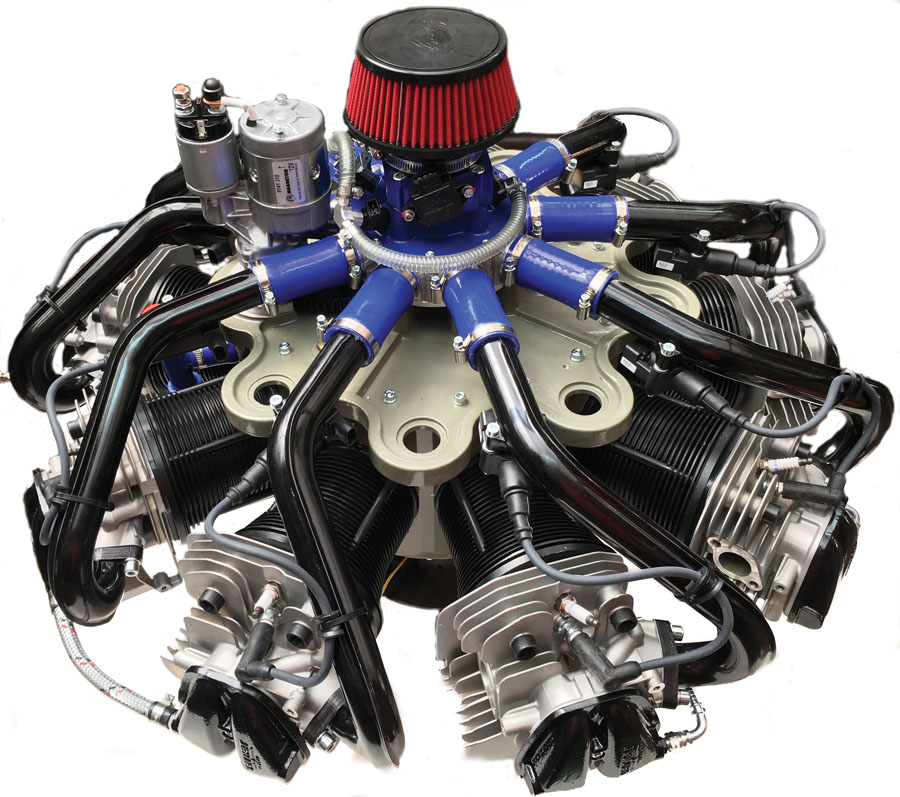
Rear view of Scarlett 9S showing black intake tubes, mounting plate, starter (top left), and throttle body injection unit with air cleaner (top center).
Fuel metering is provided by an off-the-shelf throttle body injection unit that comes standard on all motors. (A 40 IDF Weber carburetor can be special ordered.) The throttle body throat opening is 2.56 inches (65 millimeters) and has two main fuel injection jets and one backup jet. The backup jet is used for manual priming of the motor. Control for the unit is from a MASTER MINI Ignition TCI electronic control unit (ECU) manufactured by Czech company IMF Soft. The ECU takes inputs of engine rpm, temperature, and throttle position to generate outputs to the two main jets. The ECU even has an 8-megabyte recording capability to aid in diagnostics and tuning. Real-time tuning may be accomplished with a plug-and-play harness (included with the engine) and a laptop computer. High-pressure fuel is provided to the unit by an external electric fuel pump. The fuel exits the pump into a special fuel filter (included) that has a pressure relief valve and return line to the fuel tank. A second fuel pump may be added to provide redundancy. From the throttle body unit, the fuel/air mixture is delivered to each cylinder intake valve via a fiberglass intake tube. While throttle body injection is far less prone to carburetor icing because it operates with positive pressure rather than negative pressure, some source of carb heat would be prudent. The engine will operate on either 100LL or 93 octane automotive gasoline.
Lubrication is provided by 7.4 quarts (7 liters) of AeroShell 15W50 oil circulated mechanically by a gear wheel pump inside the case at the front of the engine. In a further nod to practicality and innovation, Pravoslav has located the oil filter on the front of the engine, allowing for easy oil filter changes. At ambient temperatures above 88 F (30 C), Verner recommends installing an oil cooler. Oil tank capacity of 12.7 quarts (12 liters) allows for 5.28 quarts (5 liters) of head space. The system is of a dry sump variety, necessitating the installation of the oil tank below the lowest cylinder. This configuration reduces the chances for hydraulic lock. Installing the oil tank higher will require an additional oil pump and is not recommended by Verner.
The engine is fitted with an SAE #1 prop hub. U.S. engines feature 3/8-24UNF bolts, while others use M8 bolts. Verner is currently operating their testbed Scarlett 7Si with an 86.5×51-inch wooden propeller with a 75% pitch of 14 degrees. They will use the same length propeller on the 9S in order to keep the propeller tips subsonic. Testing will determine how much pitch and/or blade width can be added with the more powerful 9S.
Showtime!
After the intriguing introduction to the Verner radial engine, we headed to the local airport for the main event. It is here that Pravoslav and Kamil conduct test activities of their engines. They built a Racek CRD aircraft to serve as the testbed. The two-place, high-wing aircraft is a copy of a Czech aircraft from the early 1930s and has an empty weight of about 660 pounds (300 kg). It currently boasts a 137-hp Verner Scarlett 7Si. The engine has been in use for two years and has about 300 hours on it. It is the biggest and most powerful engine that they have flown so far.
Pravoslav prepared the engine for starting by draining the lower cylinders and pulling the propeller through several times. This procedure minimizes the chance of hydraulic lock in the radial engine. As I watched with anticipation, he climbed in and engaged the starter. Without even the slightest hesitation, the engine roared to life and then settled into the delightful rumbling lope that one might hear from a big block Chevy engine with a high-lift camshaft. He applied full throttle, and with a quartering tailwind and a full-throated roar, he was airborne in less than 4 seconds and under 100 yards. He made a few flybys to further show off his creation. The flybys sounded more like what one would expect from a WW-II radial-engine fighter, rather than a homebuilt with an experimental engine.
After a greased-on landing, he taxied in and invited me into the front seat. I thought to myself, that 3.5-hour drive from Vienna sure was worth it! With application of full throttle, the acceleration was good, and the roar of the engine was music to the ears. The tail was airborne almost immediately, and the takeoff run increased to barely six seconds with my added weight. After breaking ground, the climb performance was astounding. Review of ground-based video of the climb-out revealed a climb angle of about 30 degrees, and that’s exactly what it felt like. Throughout the entire experience, the engine roared along smoothly, never missing a beat and was responsive to every throttle input. It was a truly reassuring experience, giving me much peace of mind regarding the amount of money that I had deposited on an engine that is still under development!
After soaking in the scenery of the tranquil mountain valley, we landed and headed back to the shop. Pravoslav was much like a proud father with his firstborn son, grinning ear to ear at each question that I asked. After an entirely rewarding visit, Pravoslav and Kamil sent me on my way with a souvenir Verner Motor ball cap.
For those desiring to purchase a Verner engine, visit the company website at www.vernermotor.com and locate a dealer in your home country (there are three in the USA). The price of the engines varies directly with the exchange rate of the Euro. Verner is currently concentrating on the 7- and 9-cylinder models. The 3VW and 5VW models are still available, but they are produced only in batches, resulting in long lead times. At the time of this writing (March 2018), the lead time for the 7U is approximately five months. For engines with lead times of longer than 60 days, a 40% deposit is expected; otherwise payment in full is necessary. Payment is made to the dealer, who will then forward the payment to Verner and make shipping arrangements. It is generally easier to have the engine shipped to the dealer as they are familiar with complex customs procedures. The dealer will inspect the engine prior to arranging further shipment to the customer. The true fun begins once the engine arrives at your doorstep!

